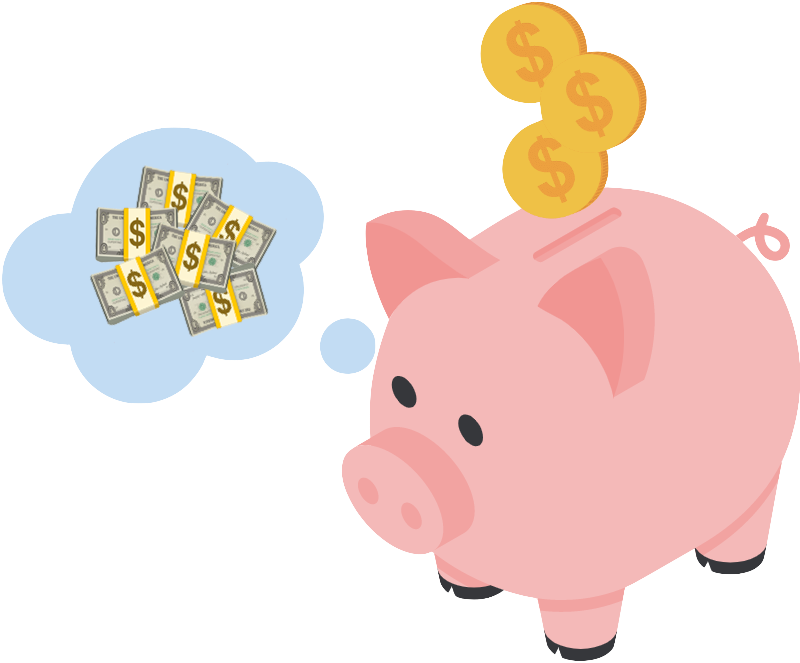If you want to achieve F.I.R.E. (financial independence retire early) and retire early, and looking to get out of the rat race ASAP then read on! Are you interested in keeping your expenses way down even in an inflationary environment? Then you’ve come to the right place!
As inflation runs rampant, it’s weird but also awesome to be able to spend less than ever before. Spending less money helps you to achieve F.I.R.E. faster in two complementary ways. First, spending less means you free up more capital to invest. Second, a lower spending level creates a lower threshold for achieving F.I.R.E.
Do you see how that works? You get to invest more toward an easier target. It’s twice as powerful! There are three effective strategies that can be used to keep your expenses very low.
Today, I want to share with you three highly effective strategies to spend less, invest more, and achieve F.I.R.E. faster.
Track Every Penny
Let’s take a look at the first strategy. It’s all about tracking every single penny of income and expenses. That’s right! Track every single penny that comes in and goes out.

I’ve been tracking every penny of my income and my expenses for more than 10 years now. It’s been critical to my success in moving closer to F.I.R.E.
It’s like getting in your car and setting out toward a destination. Yes, but how can you know how to get there or when you’ll get there? If you don’t track speed or direction, you can’t wing it. And why would you want to?
You can’t get in your car and start driving in a random direction at a random speed. You need an exact destination and you need to travel at a particular speed to get there at a particular time.
F.I.R.E. works the same way. It involves math. The destination is the crossover point or the point at which passive income crosses over expenses. And the crossover point can be reached at a particular time based on the speed or monthly amount of your saving and investing.
Let’s say you spend two thousand dollars a month. Well, then you need two thousand dollars a month in passive income to cover that spending. And if you can build investments yielding four percent, you’d be looking at an asset base of $600,000 dollars to reach that crossover point and achieve F.I.R.E. But you need the numbers to get the answers.
You can’t pull these numbers out of thin air if you aren’t already tracking your exact expenses. Be prepared for an uncomfortable surprise. Every single person I’ve talked to over the years that didn’t track every penny in and out was shocked by how much they were spending when they did finally start to track everything.
It’s easy to assume you’re spending x or y dollars. But you know, ignorance is bliss. And most people would rather think that everything is great than confront an uncomfortable reality. This is a phenomenon that applies only to expenses. If you go and ask someone how much money they make, they know that number down to the penny, but spending — NOPE.
Most people are unaware of this exact number. This isn’t optional. You need to make this a mandatory part of your life for the rest of your life. It wasn’t until I started tracking every penny that I finally woke up. It was like the clouds disappeared and clarity finally entered my life. I felt like I had control over my destiny for the first time in my life.
Apps To Track Your Spending Habits
When I did start tracking, two things happened. First, it gave me the exact numbers I was working with. That allowed me to drop a schematic of my journey to F.I.R.E. so that I could reverse engineer my way there. I could see the destination.
Second, is the uncomfortable reality of spending more than I thought. I was motivated to get these expenses down which accelerated my journey to F.I.R.E. So, the destination became something I could reach faster.
One of the great things about living in 2022 is that there are so many easy ways to track your daily spending. I use Mint. I’ve been using it since 2010. I’m very comfortable with it now. There are countless apps that you can use. And most of these can be set up in a way that automates the tracking so that electronic spending like via a credit card gets logged and categorized. Then you can check in every few days to see where you’re at and make sure you’re staying at or under your monthly spending goal.
Spend Less: The Big Three
The second strategy is to focus on the big three. The big three you ask? Yes, I’m talking about housing, transportation, and food. So why do I call these the big three? Well, that’s because these three categories are where most people spend most of their money.
Sure it sounds great to put up a tweet on Twitter about how you should cut down on the daily latte, but that’s like paying special attention to a paper cut when you’ve got a gaping wound bleeding.
You out apply the 80/20 rule to your spending. I’m referring to the Pareto principle which states that for many outcomes roughly 80% of consequences come from roughly 20% of causes.
If you start tracking and categorizing your monthly expenses you might see that you have 10 or 15 different expense categories. The mobile phone is a spending category, your internet access is another, and so on and so forth. And when you look at all your spending, housing, transportation, and food might only be 20% of the categories. But if you look at the numbers from a high level you’ll notice that 80% of your spending comes from these three categories. And so you want to focus 80% of your efforts on the 20% of your spending categories that likely account for 80 of your total monthly spending.
You need to be relentless with these three spending categories and hammer them down. There’s an old saying out there about how to a hammer everything looks like a nail. Well, this is the time when you want to be a hammer and these three nails need to be smashed.
But how do you go about doing that if you want to achieve F.I.R.E. quickly? This is where you need to think about being extreme. This is the point at which things become easy and difficult. It’s easy for me to tell you how to go about getting these expenses weighed down, but it’s difficult to actually implement extreme changes in your life. Talk is cheap and actions speak louder than words.
So, what are some extreme ways in which to get the Big Three way down? How to spend less money and save more?
Housing
I’m a big fan of renting cheap small and favorably located apartments. It’s easier to right-size an apartment than a house. Also, houses tend to be built in far-off places that need cars.
Transportation
This brings me to my second point which is transportation. If possible, live a car-free life. Walk, bike, use an e-scooter, whatever, not a car. Cars are huge burdens and expenses.
Food
How to spend less money on food? Food is easy if you’re in the USA. Limit or avoid restaurant visits. Make your own sandwiches, pasta, or whatever else you like to eat. Paying someone else to make your food, serve you, and wash your dishes is an expensive luxury. If you can afford to do that, post-F.I.R.E., great, but this is something you’ve got to eliminate on your way to F.I.R.E.
Geographic Arbitrage
The third strategy is to execute geographic arbitrage. Geographic arbitrage can change your life. What’s this concept all about? Well, geographic arbitrage is usually thought of as earning in a strong currency and spending in a weaker currency. And so, you do this by setting up passive income, business income, and/or remote income in a developed country like the US, Australia, or the UK. And then you, move to a cheaper developing country like Mexico, Thailand, or the Philippines.
You geographically untether the income which geographically untethers you after all. One of the best things about being financially independent is being geographically independent.
International Geo Arbitrage

For example, you could execute geographic arbitrage by moving from the US to Thailand. You would earn in US dollars but spend in Thai baht. You would take advantage of the fact that a dollar goes a long long long way in Thailand after converting to baht.
The current exchange rate as of this writing is: 1.0 USD = 35.8602 THB
You could rent a luxury fully furnished apartment in Thailand that’s located in a great walkable location and pay 14,000 baht. That’s around $400 a month!
You could easily live without a car, knocking your transportation spending down to nearly zero dollars a month. And you could get a good meal there for about two bucks! Your food spending would be at rock bottom levels. And that is the power of geographic arbitrage.
Now, this is geographic arbitrage in the international sense which I think is the more common way to think about it and execute it. But you can commit geographic arbitrage domestically too.
Domestic Geo Arbitrage
Geographic arbitrage is basically taking advantage of the lower cost of living in one physical location relative to another physical location. Once you’ve set up your income in a way that’s geographically untethered this can easily be done in the US.
The US is a massive country. Some places in the US are expensive and some places are cheap. Some places have lots of opportunities whereas some don’t. For example, you could move to another state to take advantage of a more diversified economy with more job opportunities, no state income tax, and a better climate for living.
Do domestic geographic arbitrage first before upping the ante and doing an international one later. It would allow you to build the foundation for your journey to F.I.R.E. and actually achieve F.I.R.E.
The US is massive with plenty of places to consider. There are cheap areas to live in all over the US but you might have to move. Maybe it means moving states, or you move to a cheaper city across your state.
There are plenty of American expats over in Thailand. And most of them complain about how expensive the US is. But, these expats come from expensive places like San Francisco, Boston, or Miami. They almost never come from places like Omaha, Tulsa, or El Paso. You can move from almost anywhere along either coast in the states to almost anywhere in the interior of the country and save a lot of money. It might be a less exciting place to live, but there are trade-offs to everything in life.
You need to figure out which benefits are worth the drawbacks if you want to achieve F.I.R.E. asap. You need to make tough choices and accept certain drawbacks. The greater benefits of F.I.R.E. outweigh the bigger drawback of spending most of your waking hours at a job you don’t like.
A lot of people seek out luxuries, like a nice car, a boat, a big house, or fancy clothes, but I couldn’t imagine a fancier luxury than financial freedom. What would you rather own than your time if attaining the greatest luxury in life meant moving away from the place where you are used to?
Consider executing geographic arbitrage by taking your untethered income and spending it in a cheaper place where your dollar goes much further.
Did you learn anything new about geographic arbitrage and the strategies to spend less, invest more, and achieve F.I.R.E. faster? I would love to hear some feedback! Leave a comment or two below. Thanks!
